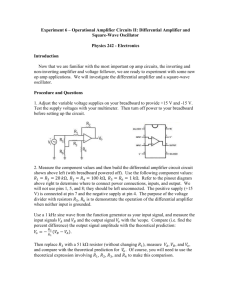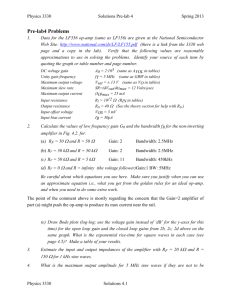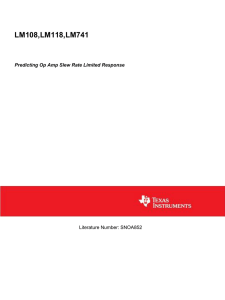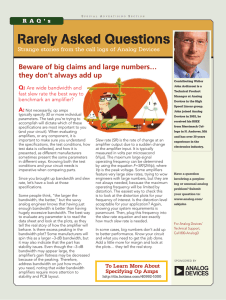Slew Rate - Technical Note
advertisement
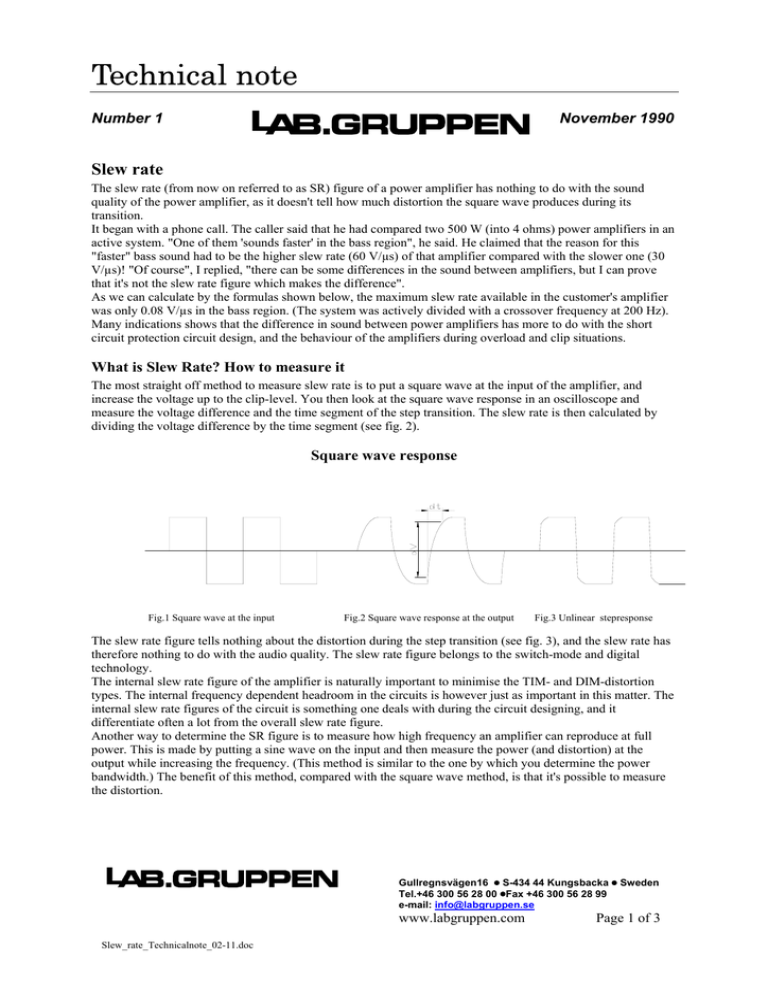
Technical note Number 1 November 1990 Slew rate The slew rate (from now on referred to as SR) figure of a power amplifier has nothing to do with the sound quality of the power amplifier, as it doesn't tell how much distortion the square wave produces during its transition. It began with a phone call. The caller said that he had compared two 500 W (into 4 ohms) power amplifiers in an active system. "One of them 'sounds faster' in the bass region", he said. He claimed that the reason for this "faster" bass sound had to be the higher slew rate (60 V/µs) of that amplifier compared with the slower one (30 V/µs)! "Of course", I replied, "there can be some differences in the sound between amplifiers, but I can prove that it's not the slew rate figure which makes the difference". As we can calculate by the formulas shown below, the maximum slew rate available in the customer's amplifier was only 0.08 V/µs in the bass region. (The system was actively divided with a crossover frequency at 200 Hz). Many indications shows that the difference in sound between power amplifiers has more to do with the short circuit protection circuit design, and the behaviour of the amplifiers during overload and clip situations. What is Slew Rate? How to measure it The most straight off method to measure slew rate is to put a square wave at the input of the amplifier, and increase the voltage up to the clip-level. You then look at the square wave response in an oscilloscope and measure the voltage difference and the time segment of the step transition. The slew rate is then calculated by dividing the voltage difference by the time segment (see fig. 2). Square wave response Fig.1 Square wave at the input Fig.2 Square wave response at the output Fig.3 Unlinear stepresponse The slew rate figure tells nothing about the distortion during the step transition (see fig. 3), and the slew rate has therefore nothing to do with the audio quality. The slew rate figure belongs to the switch-mode and digital technology. The internal slew rate figure of the amplifier is naturally important to minimise the TIM- and DIM-distortion types. The internal frequency dependent headroom in the circuits is however just as important in this matter. The internal slew rate figures of the circuit is something one deals with during the circuit designing, and it differentiate often a lot from the overall slew rate figure. Another way to determine the SR figure is to measure how high frequency an amplifier can reproduce at full power. This is made by putting a sine wave on the input and then measure the power (and distortion) at the output while increasing the frequency. (This method is similar to the one by which you determine the power bandwidth.) The benefit of this method, compared with the square wave method, is that it's possible to measure the distortion. Gullregnsvägen16 S-434 44 Kungsbacka Sweden Tel.+46 300 56 28 00 Fax +46 300 56 28 99 e-mail: info@labgruppen.se www.labgruppen.com Slew_rate_Technicalnote_02-11.doc Page 1 of 3 Technical note Number 1 November 1990 Calculations To determine how large the SR must be to reproduce a sine wave frequency, we must derive the formula for a sine wave: π= π π π Û=U √ √ π Û √ √ Sine wave: U = Upeak * sin ωt U= instantaneous voltage Upeak = maximum voltage swing available Derivate: dU = Upeak ω cos ωt dt ω = 2 πf f = frequency The max dU is then cos ωt = 1 dt dU (max) = Upeak ω = Upeak 2πf dt √ dU is the SR dt The voltage U can be calculated from the output power: P = U2 z z = loudspeaker impedance Upeak = √ P z The U for a sine wave is U= √ 2 P z By substituting U the SR. can be calculated: SR = 2·π·f ·√ 2·P·z In the above we can see that the SR is simply a product of the voltage (max power) and the maximum frequency. The maximum frequency can be set to 20 kHz, as we can't hear higher frequencies. (CD-players have for example a steep filter to suppress all higher frequencies.) We can now make a table which shows the maximum slew rate needed to produce a sine wave at different power levels and speaker impedance’s (see table 1). Gullregnsvägen16 S-434 44 Kungsbacka Sweden Tel.+46 300 56 28 00 Fax +46 300 56 28 99 e-mail: info@labgruppen.se www.labgruppen.com Slew_rate_Technicalnote_02-11.doc Page 2 of 3 Technical note Number 1 November 1990 Speaker impedance in ohms Power in watts 2 4 8 16 10 0.8 1.1 1.6 2.3 20 1.1 1.6 2.3 3.2 50 1.8 2.5 3.6 5.0 100 2.5 3.6 5.0 7.1 200 3.6 5.0 7.1 10.0 500 5.6 7.9 11.2 15.9 1000 7.9 11.2 15.9 22.9 Table 1. Maximum slew rate [V/µs] to produce a 20kHz sine wave in different load impedance’s and power levels. How much slew rate do we need? We can see that most power amplifiers have more than enough SR to produce full power at 20 kHz. We can also conclude that a 16 ohms load at high power needs the highest SR figure, (as 16 ohms needs the highest voltage for a specific power). From the calculations above we can see that we need the highest SR in the treble region, that is at 20 kHz. As the SR is a product of the maximum frequency and the maximum power, the next question must be how much power it will need at 20 kHz? The commercially available compressor drivers have a highest power rate of not over 200 W in 16 ohms. A quick look in the table 1 shows that we don't need more than 10 V/µs. If we increase the SR we must either increase the frequency above 20 kHz (and we don't hear that) or exceed the power rating (200 W) and then the driver will burn. Conclusion The conclusion must be that the majority of the commercially available power amplifiers have an overkill of 3 to 10 times of the necessary linear (distortion free) slew rate figure. Gullregnsvägen16 S-434 44 Kungsbacka Sweden Tel.+46 300 56 28 00 Fax +46 300 56 28 99 e-mail: info@labgruppen.se www.labgruppen.com Slew_rate_Technicalnote_02-11.doc Page 3 of 3


